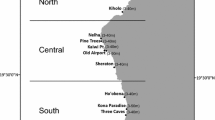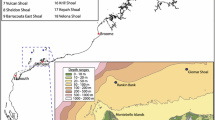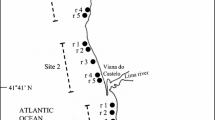Abstract
The physical and biological structure of coral reef habitats vary in relation to depth and the profile of the reef, from vertical walls to gentle slopes. The differing roles of depth and reef profile on fish distribution and abundance, and the role of habitat structure in explaining these patterns, have received little attention. Here these effects were distinguished by surveying reef fish species and benthic habitat in quadrats on three aspects (shelf, slope and wall) at each of two depths (5 m and 15 m) in Kimbe Bay, Papua New Guinea. Both depth and reef profile accounted for considerable variation in reef fish communities. Species diversity and richness was highest on the shelf profile and lowest on the wall profile at 5 m. Whereas, at 15 m the opposite was true with the wall profile being the most diverse and species rich profile and the shelf being the least. Wall habitats were the most different from the other two profiles in terms of community structure. Depth had a greater influence on fish communities on slope and shelf habitats, with shallow slopes and shelfs similar to one another, and deep slopes and shelfs also similar. Some rare species, such as Chromis delta and Pictichromis paccagnellae, were restricted only to walls. The relative effects of depth and reef profile on benthic habitat structure were similar to the fish communities, with the sponge and encrusting coral dominated wall habitats being the most dissimilar to the other aspects, with clear depth patterns also. There was a significant correlation between the fish communities present and the habitat availability at the depths and on the reef profiles studied. The correlation was best explained by sand, branching coral, encrusting coral, massive coral and rubble. Depth and reef profile had a significant interaction, which suggests that, clearly, both depth and profile are important factors affecting reef fish communities. Although, benthic habitat appears to only partially explain these patterns.




Similar content being viewed by others
References
Anderson MJ (2001) A new method for non-parametric multivariate analysis of variance. Aust Ecol 26:32–46
Arias-Gonzalez JE, Done TJ, Page CA, Cheal AJ, Kininmonth S, Garza-Perez JR (2006) Towards a reefscape ecology: relating biomass and trophic structure of fish assemblages to habitat at Davies Reef, Australia. Mar Ecol Prog Ser 320:29–41
Bay LK, Jones GP, McCormick MI (2001) Habitat selection and aggression as determinants of spatial segregation among damsel fish on a coral reef. Coral Reefs 20:289–298
Bean K, Jones GP, Caley MJ (2002) Relationships between distribution, abundance and microhabitat specialisation in a guild of coral reef triggerfish (Family Balistidae). Mar Ecol Prog Ser 233:263–272
Bell JD, Galzin R (1984) Influence of live coral cover on coral-reef fish communities. Mar Ecol Prog Ser 15:265–274
Bonin MJ, Srinivasan M, Almany GR, Jones GP (2009) Interactive effects of interspecific competition and microhabitat on early post settlement survival in a coral reef fish. Coral Reefs 28:265–274
Bonin MJ, Almany GR, Jones GP (2011) Contrasting effects of habitat loss and fragmentation on coral-associated reef fishes. Ecology 92:1503–1512
Brokovich E, Baranes A, Goren M (2006) Habitat structure determines coral reef fish assemblages at the northern tip of the Red Sea. Ecol Indic 6:494–507
Brokovich E, Einbinder S, Shasar N, Kiflawi M, Kark S (2008) Descending into the twilight zone: changes in coral reef fish assemblages along a depth gradient down to 65 m. Mar Ecol Prog Ser 371:253–262
Brokovich E, Ayalon I, Einbinder S, Segev N, Shaked Y, Genin A, Kark S, Kiflawi M (2010) Grazing pressure on coral reefs decreases across a wide depth gradient in the Gulf of Aqaba, Red Sea. Mar Ecol Prog Ser 399:69–80
Brooker RM, Munday PL, Mcleod IM, Jones GP (2013) Habitat preferences of a corallivorous reef fish: predation risk versus food quality. Coral Reefs 32:613–622
Chabanet P, Ralambondrainy H, Amanieu M, Faure G, Galzin R (1997) Relationships between coral reef substrata and fish. Coral Reefs 16:93–102
Clarke RD (1989) Population fluctuation, competition and microhabitat distribution of two species of tube blennies, Acanthemblemaria (Teleostei: Chaenopsidae). Bull Mar Sci 44:1174–1185
Clarke KR (1993) Non-parametric multivariate analyses of changes in community structure. Aust J Ecol 18:117–143
Donaldson TJ (2002) Habitat association and depth distribution of two sympatric groupers of the genus Cephalopholis (Serranidae: Epinephelinae). Ichthyol Res 49:191–193
Eagle JV, Jones GP, McCormick MI (2001) A multi-scale study of the relationships between habitat use and the distribution and abundance patterns of three coral reef angelfishes (Pomacanthidae). Mar Ecol Prog Ser 214:253–265
Einbinder S, Mass T, Brokovich E, Dubinsky Z, Erez J, Tchernov D (2009) Changes in morphology and diet of the coral Stylophora pistillata along a depth gradient. Mar Ecol Prof Ser 381:167–174
Friedlander AM, Parrish PD (1998) Habitat characteristics affecting fish assemblages on a Hawaiian coral reef. J Exp Mar Biol Ecol 224:1–30
Fulton CJ, Bellwood DR (2005) Wave induced water motion and the functional implications for coral reef fish assemblages. Limnol Oceanogr 50(1):255–264
Fulton CJ, Bellwood DR, Wainwright PC (2005) Wave energy and swimming performance shape coral reef fish assemblages. Proc R Soc B 272:827–832
Garpe KC, Öhman MC (2003) Coral and fish distribution patterns in Mafia Island Marine Park, Tanzania: fish-habitat interactions. Hydrobiologia 498:191–211
Garpe KC, Yahya SAS, Lindahl U, Öhman MC (2006) Long-term effects of the 1998 coral bleaching event on reef fish assemblages. Mar Ecol Prog Ser 315:237–247
Gonzalez-Sanson G, Aguilar C, Hernandez I, Cabrera Y (2009) Effects of depth and bottom communities on the distribution of highly territorial reef fish in the northwestern region of Cuba. J Appl Ichthyol 25:652–660
Graham NAJ, Wilson SK, Jennings S, Polunin NVC, Bijoux JP, Robinson J (2006) Dynamic fragility of oceanic coral reef ecosystems. Proc Natl Acad Sci U S A 103:8425–8429
Gratwicke B, Speight MR (2005) Effects of habit complexity on Caribbean marine fish assemblages. Mar Ecol Prog Ser 292:301–310
Green AL (1996) Spatial, temporal and ontogenetic patterns of habitat use by coral reef fishes (Family: Labridae). Mar Ecol Prog Ser 133:1–11
Gutierrez L (1998) Habitat selection by recruits establishes local patterns of adult distribution in two species of damselfishes: Stegastes dorsopunicans and S. planifrons. Oecologia 115:268–277
Hawkins AFA (1999) Altitudinal and latitudinal distribution of East Malagasy forest bird communities. J Biogeogr 26:447–458
Hendriks IE, Wilson DT, Meekan MG (2001) Vertical distribution of late stage larval fishes in the nearshore waters of the San Blas Archipelago, Caribbean Panama. Coral Reefs 20:77–84
Irisson J-O, Paris CB, Guigand C, Planes S (2010) Vertical distribution and ontogenetic “migration” in coral reef fish larvae. Limnol Oceanogr 55:909–919
Jones GP, McCormick MI, Srinivasan M, Eagle JV (2004) Coral decline threatens fish biodiversity in marine reserves. Proc Natl Acad Sci U S A 101:8251–8253
Krebs CJ (2006) Ecology after 100 years: progress and pseudo-progress. N Z J Ecol 30:3–11
La Peyre MKG, Grace JB, Hahn E, Mendelssohn IA (2001) The importance of competition in regulating plant species abundance along a salinity gradient. Ecology 82:62–69
Lecchini D, Tsuchiya M (2008) Spatial structure of coral reef fish communities at Kudaka Island (Ryukyu Archipelago), Japan. Ichthyol Res 55:321–327
Lecchini D, Adjeroud M, Pratchett MS, Cadoret L, Galzin R (2003) Spatial structure of coral reef fish communities in the Ryukyu Islands, Southern Japan. Oceanol Acta 26:537–547
Leis JM (1986) Vertical and horizontal distribution of fish larvae near coral reefs at Lizard Island, Great Barrier Reef. Mar Biol 90:505–516
Leis JM (1991) Vertical distribution of fish larvae in the Great Barrier Reef lagoon, Australia. Mar Biol 109:157–166
Mark AF, Dickinson KJM, Allen J, Smith R, West CJ (2001) Vegetation patterns, plant distributions and life forms across the alpine zone in southern Tierra Fuego, Argentina. Aust Ecol 26:423–440
Mass T, Genin A (2008) Environmental versus intrinsic determination of colony symmetry in the coral in the coral Pocillopora verrucosa. Mar Ecol Prog Ser 369:131–137
Mass T, Einbinder S, Brokovich E, Shashar N, Vago R, Erez J, Dubinsky Z (2007) Photoacclimation of Stylophora pistillata to light extremes: metabolism and calcification. Mar Biol Prog Ser 334:93–102
McGehee MA (1994) Correspondence between assemblages of coral reef fishes and gradient of water motion, depth and substrate size off Puerto Rico. Mar Ecol Prog Ser 105:243–255
Medeiros PR, Grempel RG, Souza AT, Ilarri MI, Rosa RS (2010) Non random reef use by fishes at two dominant zones in a tropical, algal dominated coastal reef. Environ Biol Fish 87:237–246
Meeken MG, Steven ADL, Fortin MJ (1995) Spatial patterns in the distribution of damselfishes on a fringing coral reef. Coral Reefs 14:151–161
Nunez-Lara E, Arias-Gonzalez E (1998) The relationship between reef fish community structure and environmental variables in the southern Mexican Caribbean. J Fish Biol 53(supp A):209–221
Pratchett MS, Berumen ML (2008) Interspecific variation in distributions and diets of coral reef butterflyfishes (Teleostei: Cheatodontidae). J Fish Biol 73:1730–1747
Pratchett MS, Coker DJ, Jones GP, Munday PL (2012) Specialisation in habitat use by coral reef damselfishes and their susceptibility to habitat loss. Ecol Evol 2:2168–2180
Russ G (1984) Distribution of herbivorous grazing fishes in the Central Great Barrier Reef. II. Patterns of zonation of mid-shelf and outer-shelf reefs. Mar Ecol Prog Ser 20:35–44
Shpigel M, Fishelson L (1989) Habitat partitioning between species of the genus Cephalopholis (Pisces, Serranidae) across the fringing reef of the Gulf of Aqaba (Red Sea). Mar Ecol Prog Ser 58:17–22
Srinivasan M (2003) Depth distributions of coral reef fishes: the influence of microhabitat structure, settlement and post settlement processes. Oecologia 137:76–84
Wilson SK, Graham NAJ, Pratchett MS, Jones GP, Polunin NVC (2006) Multiple disturbances and the global degradation of coral reefs: are reef fishes at risk or resilient? Global Change Biol 12:2220–2234
Acknowledgments
We are grateful to the traditional owners of the Tamare-Kilu reefs for allowing us access to their reefs as well as to Mahonia Na Dari Research and Conservation Centre and Walindi Plantation Resort for their logistical support. Thank you also to the boat drivers Michael and Blazius, to A. Cole and A. Coppock for all their support and aid in the field and to C. Mattone and P. Pereira for their help with the statistics and graphs. Finally thank you also to N. Graham for your helpful insights and comments on the paper. This research was carried out under the approval of the James Cook University Animal Ethics Committee.
Author information
Authors and Affiliations
Corresponding author
Electronic supplementary material
Below is the link to the electronic supplementary material.
ESM 1
(DOC 271 kb)
Rights and permissions
About this article
Cite this article
Jankowski, M.W., Gardiner, N.R. & Jones, G.P. Depth and reef profile: effects on the distribution and abundance of coral reef fishes. Environ Biol Fish 98, 1373–1386 (2015). https://doi.org/10.1007/s10641-014-0365-1
Published:
Issue Date:
DOI: https://doi.org/10.1007/s10641-014-0365-1




